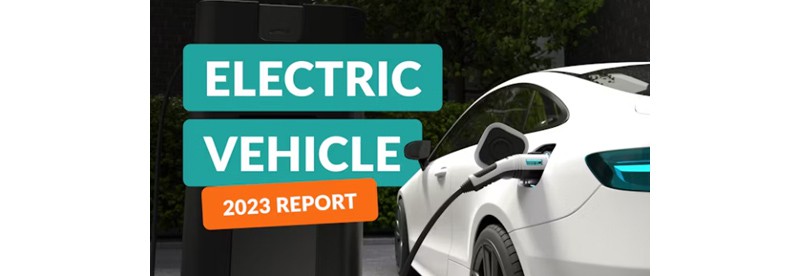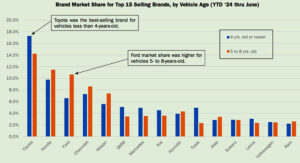Several states have experienced high growth in EV adoption, with Oklahoma leading the pack (110.6% increase) and Arkansas not far behind
With the global focus on expanding the electric vehicle (EV) market and the impending ban on diesel and gasoline vehicle sales in the US by 2035, the prospect of owning an electric vehicle is becoming a reality for many future drivers.
However, as the US is a vast country with each state operating under its own rules and regulations, the readiness of the nation for a widespread adoption of electric vehicles varies significantly. To assess the current state of EV infrastructure, Zutobi, an online driver’s education resource, has provided its updated 2023 US Electric Vehicle Charging Station Report.
The following are key takeaways and highlights from the study.
- The number of EVs in the US has increased by 42% since the last edition of the report, increasing from 1,019,260 to 1,454,580.
- However, the growth in public charging outlets hasn’t quite matched that, growing from 128,549 to 143,771 over the same period, an increase of around 12%.
States with the most charging stations per EVs
FIRST PLACE — NORTH DAKOTA
• Total electric charging ports: 172
• Registered EVs: 380
• Charging stations per 100 EVs: 45.3
North Dakota leads in terms of charging stations per EVs. With a total of 172 electric charging ports and 380 registered EVs, the state boasts an impressive ratio of 45.3 charging stations per 100 EVs.
While the state actually has the lowest number of electric vehicles overall, the fact that it has such a high ratio of chargers suggests that the state is trying to encourage residents to make the switch to EVs.
SECOND PLACE — WYOMING
• Total electric charging ports: 213
• Registered EVs: 510
• Charging stations per 100 EVs: 41.8
Another state that has a relatively low uptake of electric vehicles, but with a comparatively high number of chargers is Wyoming, with 41.8 charging stations per 100 EVs.
Wyoming is one of a number of states in the United States that received government funding to create a network of chargers connecting highways right from the Atlantic Coast to the Pacific.
THIRD PLACE — WEST VIRGINIA
• Total electric charging ports: 386
• Registered EVs: 1,010
• Charging stations per 100 EVs: 38.2
Not far behind Wyoming in terms of its rate of chargers to cars is West Virginia, with 38.2 charging points for every 100 EVs.
The number of registered EVs in West Virginia is relatively low, but with a decent charging infrastructure starting to develop could encourage more people to make the change.
States with the fewest charging stations per EVs
FIRST PLACE — NEW JERSEY
• Total electric charging ports: 2,694
• Registered EVs: 47,830
• Charging stations per 100 EVs: 5.6
New Jersey, despite having a high number of registered EVs at 47,830, falls short in terms of charging infrastructure. The state currently offers 2,694 electric charging ports, resulting in 5.6 charging stations per 100 EVs.
To incentivize EV ownership and support the expansion of charging infrastructure, the state of New Jersey has launched initiatives. The state provides grants to offset the cost of purchasing and maintaining electric vehicle charging stations.
It’s worth noting that New Jersey has made remarkable progress in improving its charging infrastructure. In fact, the state ranks among the top three states with the biggest increase in charging points, boasting a significant growth rate of 33.37% compared to the previous 2022 report. This positive development underscores New Jersey’s commitment to enhancing its EV charging network and accommodating the increasing demand for electric vehicles.
SECOND PLACE — ARIZONA
• Total electric charging ports: 2,638
• Registered EVs: 40,740
• Charging stations per 100 EVs: 6.5
Arizona faces a similar challenge, with 2,638 charging ports and 40,740 registered EVs. This translates to 6.5 charging stations per 100 EVs. The state could focus on expanding its charging infrastructure to better support the growing EV population. During the last year, the number of charging points increased by 17%.
THIRD PLACE — HAWAII
• Total electric charging ports: 940
• Registered EVs: 14,740
• Charging stations per 100 EVs: 6.6
Hawaii, despite being a pioneer in renewable energy adoption, lags behind in terms of charging infrastructure. The state currently offers 940 electric charging ports for its 14,740 registered EVs, resulting in a ratio of 6.6 charging stations per 100 EVs. Continued investment in charging infrastructure will be important for fostering EV growth in the state.
States with the highest percentage of electric vehicles on the road
FIRST PLACE — CALIFORNIA
• Registered EVs: 563,070
• Registered private automobiles: 14,027,931
• EVs as % of automobiles: 4.01%
California leads the nation in terms of EV adoption. With 563,070 registered EVs and 14,027,931 registered private automobiles, electric vehicles account for approximately 4.01% of the total automobiles in the state.
SECOND PLACE — HAWAII
• Registered EVs: 14,220
• Registered private automobiles: 456,261
• EVs as % of automobiles: 3.12%
The island state of Hawaii may seem like a surprising place for an EV success story, but there are strong incentives, short driving distances, and a climate that lends itself to EV performance.
Hawaii ranks second, with 14,220 registered EVs and 456,261 registered private automobiles. Electric vehicles constitute around 3.12% of the state’s total automobiles. Considering Hawaii’s unique geographic challenges and commitment to clean energy, the state is making progress in EV adoption.
THIRD PLACE — COLORADO
• Registered EVs: 37,000
• Registered private automobiles: 1,479,975
• EVs as % of automobiles: 2.50%
Colorado holds the third position, with 37,000 registered EVs and 1,479,975 registered private automobiles. Electric vehicles account for approximately 2.50% of the state’s total automobiles. Colorado’s efforts to incentivize EV adoption and develop charging infrastructure have contributed to its significant market share of electric vehicles.
The US states with the lowest proportion of electric vehicles on the road
FIRST PLACE — MISSISSIPPI
• Registered EVs: 1,310
• Registered private automobiles: 891,658
• EVs as % of automobiles: 0.15%
Mississippi has the lowest proportion of electric vehicles on its roads. With only 1,310 registered EVs out of a total of 891,658 registered private automobiles, EVs constitute 0.15% of the state’s total automobile population.
SECOND PLACE — NORTH DAKOTA
• Registered EVs: 380
• Registered private automobiles: 208,03
• EVs as % of automobiles: 0.18%
North Dakota, despite its strong charging infrastructure, has a relatively low proportion of EVs on the road. With only 380 registered EVs among 208,030 registered private automobiles, electric vehicles account for just 0.18% of the state’s total automobile population.
THIRD PLACE — SOUTH DAKOTA
• Registered EVs: 680
• Registered private automobiles: 311,336
• EVs as % of automobiles: 0.22%
South Dakota also faces a similar challenge. The state has 680 registered EVs out of 311,336 registered private automobiles, resulting in an EV proportion of 0.22%.
How have the number of EVs and charging stations in the US changed?
Following the 2020 election, the Biden administration announced that it expects 50% of all vehicles sold in the country to be electric by 2030 and the sale of fossil fuel vehicles banned by 2035, accomplished through purchase incentives, taxes and restrictions on internal combustion vehicles, new congestion charging zones and tougher emissions standards.
Since first taking a look at the EV charging station infrastructure in the US a year ago, the numbers of both electric vehicles themselves and chargers have both continued to increase.
Several states have experienced significant growth in EV adoption since the last report. Oklahoma leads the pack, with a 110.6% increase in registered EVs, increasing from 3,410 to 7,180. Arkansas follows closely, with a growth rate of 79.7%, seeing EV numbers rise from 1,330 to 2,390. Montana, North Dakota, and South Carolina also demonstrate substantial growth in EV adoption.
Michigan takes the top spot in terms of the growth in charging infrastructure, with a 49.34% increase in the number of electric charging points, increasing from 1,806 to 2,697. Maine and New Jersey follow suit, showcasing notable growth rates of 35.37% and 33.37%, respectively.
Methodology
The number of charging outlets in each state was sourced from the Alternative Fuels Data Center’s Alternative Fueling Station Count by State, taking the number of electric EVSE ports in each state.
The number of electric vehicles in each state was sourced from the Alternative Fuels Data Center’s Electric Vehicle Registrations by State data and refers to the number of registered electric vehicles as of December 31, 2022.The number of vehicles registered in each state was sourced from the Federal Highway Administration’s Highway Statistics and refers to the total number of private and commercial automobiles including taxicabs).





Comments are closed.